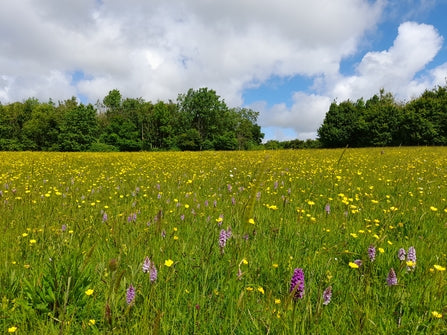
CARING FOR WILDFLOWER MEADOWS
Share
Wildflower meadows are incredibly low-maintenance once established, but they do require a bit of attention to keep them thriving year after year. Whether you're nurturing a recently sowed meadow or maintaining an established one, these essential tips will help you create a vibrant, sustainable habitat that benefits local wildlife.
WEED CONTROL AND SOIL HEALTH
In the first few months after sowing, it’s important to prevent weeds from overtaking young plants. Weeds can quickly compete for resources, so use a hoe or pull them by hand to ensure your wildflowers have enough space to grow.
Once your wildflowers have become well-established after their first year, they will be better equipped to outcompete weeds. If you have rich, fertile soil, consider adding sand, grit, or organic matter to reduce the nutrients, simulating the poor soil conditions that wildflowers naturally prefer.
CUTTING BACK AND DEADHEADING
For your wildflower meadow to remain healthy and continue flourishing, it's essential to cut back plants after they've finished flowering. Late autumn is the best time to mow or scythe the meadow to around 2–3 inches. This will encourage new growth in the spring and help maintain a tidy, attractive meadow.
Some species, like poppies, will self-seed, but deadheading will prevent them from becoming too invasive. Additionally, leaving some seed heads intact will provide a valuable food source for wildlife throughout the winter. If poppies are your favorite, consider Poppy Patch, our stunning red single-species option, which will add a vibrant burst of color to your meadow.
SEASONAL CARE
While wildflower meadows are naturally resilient, seasonal care ensures they remain in top condition. In spring, rake through the meadow to clear any dead plant material, allowing fresh shoots to emerge. In autumn, mow the meadow and leave the cuttings to break down naturally, adding valuable nutrients back into the soil. By sticking to a simple routine of cutting and clearing, you'll encourage healthy, diverse growth year after year, ensuring that your meadow continues to support wildlife and beauty.
Consider mixing Meadow Lace or Traditional Native Meadow to bring your wildflower meadow to life. Both blends provide a delightful mix of native species that will create an attractive, vibrant habitat for years to come.
GROWING WILDFLOWERS IN THE UK AND IRELAND
The UK and Ireland offer a wide range of growing conditions, but understanding local climate and soil types is essential for successful wildflower cultivation. From the wet, temperate conditions in the West to the sunnier, drier areas in the South and East, wildflowers are adaptable, but selecting the right species for your area will help them thrive.
SOIL AND TEMPERATURE CONDITIONS
SOIL:
Soils in the UK and Ireland can vary significantly. In the South, you may have rich, loamy soil, while the North and West are often more acidic and peat-heavy. Wildflowers generally thrive in well-drained, low-nutrient soils, so if you have heavy, fertile soil, it’s worth improving drainage by adding sand, grit, or organic matter. Radiance, our best-seller, is a versatile mix that will bloom beautifully in most soil conditions.
RAINFALL:
The UK and Ireland receive a significant amount of rainfall throughout the year, particularly in coastal and western regions. While this is ideal for growing many wildflowers, it’s important to choose species that can handle slightly wetter conditions. Species like red campion, oxeye daisy, and yarrow, found in Traditional Native Meadow, are great choices. However, in drier regions like the East and South, wildflowers like cornflower and poppies thrive. Our mixes Fiesta and Mirage offer a stunning display of bold, vibrant colors suited to these drier areas.
TEMPERATURE:
The temperate climate across the UK and Ireland is ideal for wildflowers, offering mild winters and cool summers. For colder regions like Scotland, frost-tolerant species like yarrow and field poppy (found in Traditional Native Meadow and Bee and Butterfly Haven) are perfect. For warmer regions like southern England, you can choose drought-tolerant species like corn marigold, found in Ever Reach and Native Beauty.
WIND AND EXPOSURE:
Coastal areas and uplands often experience strong winds, which can be challenging for delicate wildflowers. Consider planting in sheltered spots or adding windbreaks to protect your wildflowers and ensure a successful, thriving display.
